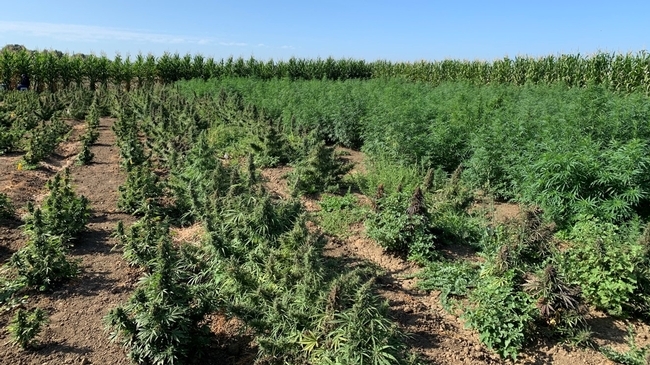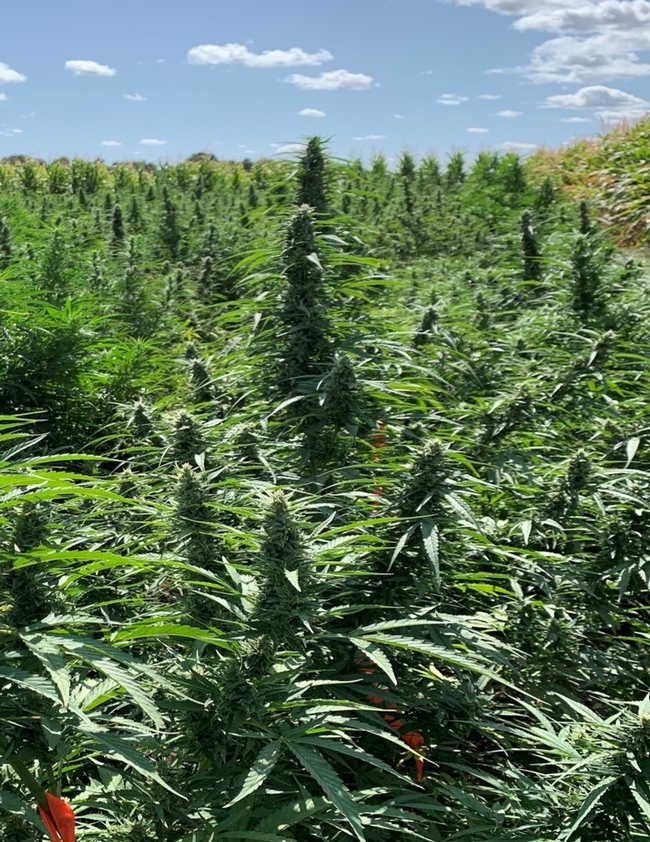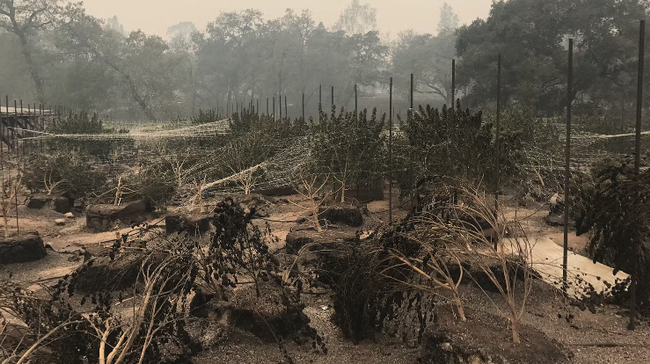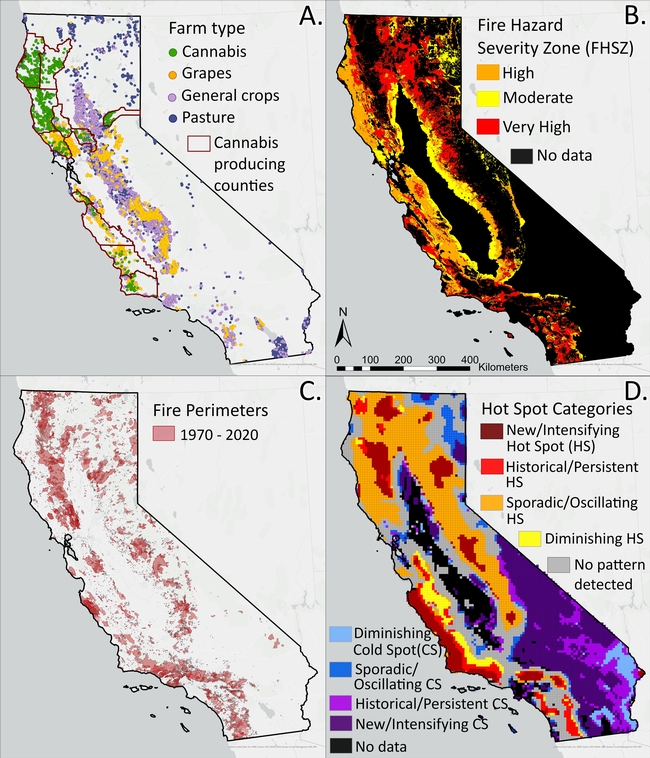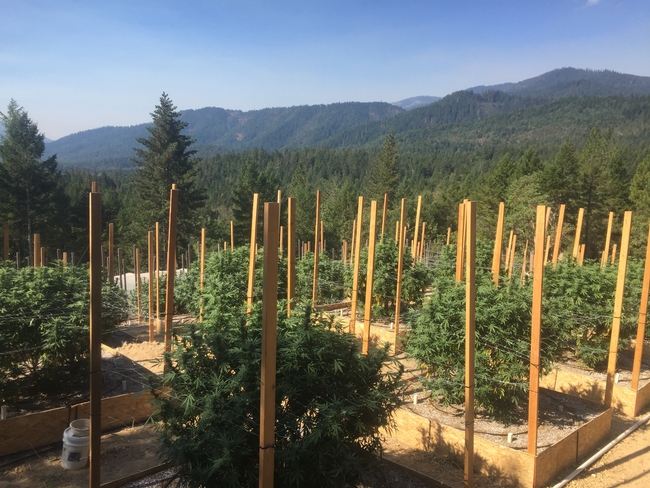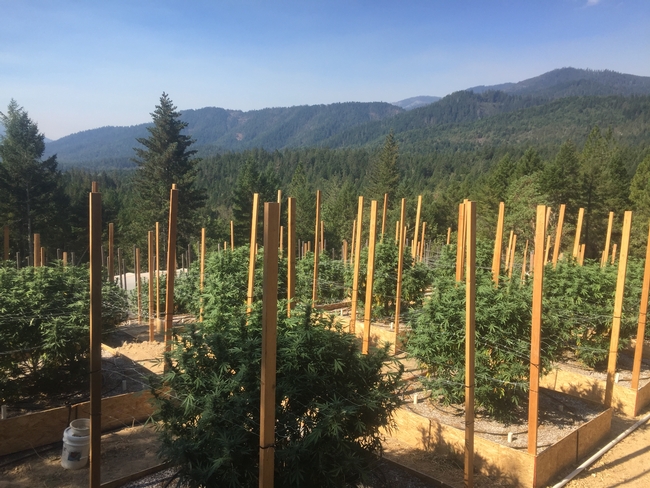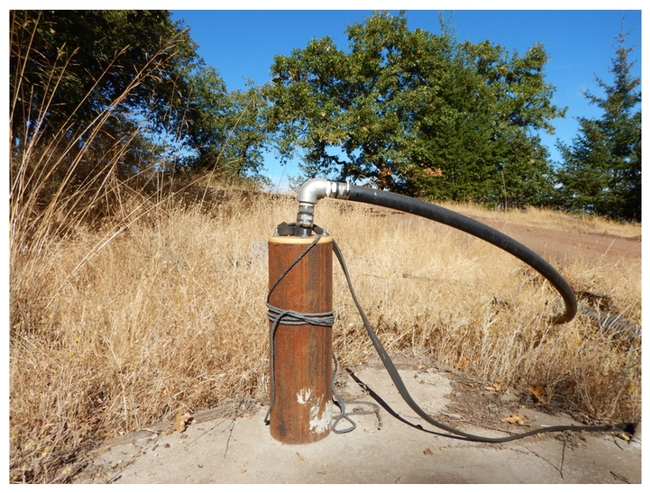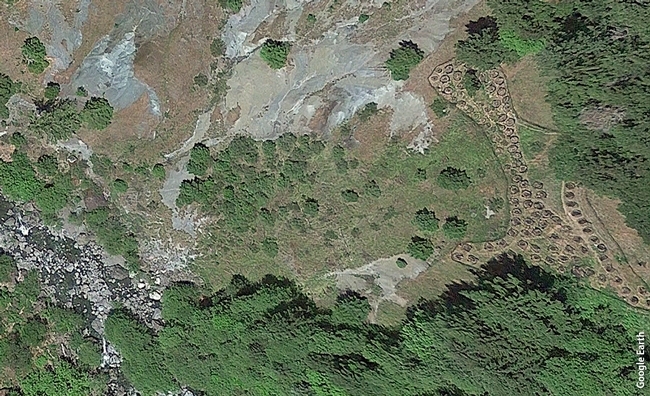Posts Tagged: Cannabis
UC to present hemp research at field day on Sept. 22
UC Cooperative Extension will host its first industrial hemp field day at UC Davis on Thursday, Sept. 22. The meeting will be held at the UC Davis Agronomy Field Headquarters on Hutchison Drive in Davis.
Industrial hemp is defined as Cannabis sativa L. and required not to exceed 0.3% THC, the intoxicating substance in marijuana.
University of California research on industrial hemp – which can be grown for oil, seed and fiber – began after the 2018 Farm Bill legalized the production of hemp as an agricultural commodity and removed it from the list of federally controlled substances.
At the field day, UC researchers will share research data and participants will explore field plots and learn about the agricultural practices commonly used for this crop.
“There is an abundance of potential end uses with hemp, and this is still very much a new crop with many research needs,” said Kadie Britt, a postdoctoral scholar in the Department of Entomology at UC Riverside and member of the management team for UC Agriculture and Natural Resources' Hemp Agroecology Network. “Growers are working to find their niche in this new and developing market.
Hemp is used as fiber for fabrics and textiles and its seed for oil and food. The cannabinoids, particularly cannabidiol, or CBD, have medicinal and recreational uses.
Registration for the free event will start at 7:30 a.m. From 8 a.m. to noon, attendees will hear from speakers representing the University of California, California Department of Food and Agriculture, California Department of Pesticide Regulation, Beneficial Insectary and Marrone Bio Innovations.
Topics will include hemp agronomy, weed pests, pathogen pests, insect pests, biocontrol use, pesticide use, pesticide resistance avoidance, and California hemp laws and regulations.
All interested people are encouraged to attend. Continuing education credits will be offered for California Department of Pesticide Regulation, Certified Crop Advisers, and Irrigation and Nitrogen Management Plan.
The agenda and more information about the field day are at https://ucanr.edu/sites/hemp/Events.
Registration is preferred, but not required: http://tinyurl.com/fielddayhemp.
Hemp Field Day Preview on KMJ 9-21-22
Wildfire poses greater threat to cannabis than other California crops
Wildfires are an increasing threat to people's lives, property and livelihoods, especially in rural California communities. Cannabis, one of California's newer and more lucrative commercial crops, may be at a higher risk of loss from wildfire because it is mostly confined to being grown in rural areas, according to new research by scientists in the Department of Environmental Science Policy and Management at UC Berkeley.
"Our findings affirm that cannabis agriculture is geographically more threatened by wildfire than any other agricultural crop in California,” said Christopher Dillis, lead author of the study and a postdoctoral researcher at UC Berkeley's Cannabis Research Center. “This is an issue in almost all major cannabis-producing counties, not only those in Northern California.”
With licensing to grow commercially in the state only since 2018, the $3 billion cannabis industry is already one of California's top five grossing agricultural commodities (though not included in the California Agricultural Production Statistics because USDA doesn't recognize cannabis as an agricultural crop). In 2020, California tax revenues from legal cannabis sales amounted to over $780 million.
To assess the risk of cannabis crops being burned by wildfire, the researchers analyzed licensed cannabis farms in 11 cannabis-producing counties. Dillis and his colleagues overlaid CAL FIRE maps of fire hazard severity zones, historic wildfire perimeters and areas likely to experience increased fire activity in the future with the locations of cannabis farms and other crops in Humboldt, Lake, Mendocino, Monterey, Nevada, San Luis Obispo, Santa Barbara, Santa Cruz, Sonoma, Trinity and Yolo counties. Legal cannabis cultivation is still prohibited in most other parts of the state.
CAL FIRE classifies fire hazard based on vegetation, topography, climate, crown fire potential, ember production and movement and fire history.
The researchers found cannabis fields were located in “high” and “very high” fire hazard zones and closer to wildfire perimeters more than any other crop. About 36% of the cannabis cultivation area, or 986 farms, were in high fire hazard zones and 24%, or 788 farms, were in very high fire hazard zones. Grapes had the next largest percentage of acreage in high (8.8%) or very high fire hazard zones (2.9%), followed by pasture at 4.3% and 1.7%, respectively.
“This work only serves as a starting point for understanding how vulnerable cannabis farms may be to wildfire, as this analysis did not include indirect impacts, such as smoke and ash damage, which may be far-reaching,” Dillis said. “However, we can confidently say that the places where cannabis continues to be grown are at greater risk now, and likely in the future as well."
For cannabis farms already established in high-risk areas, the authors recommend fire-safety programs to reduce the impacts of wildfire to crops and human health. They suggest traditional wildfire-risk reduction activities, such as managing vegetation and creating fire breaks, but also measures to prevent exposure of farmworkers and crops to wildfire smoke. In addition, they recommend the state pursue options for providing crop insurance to licensed cannabis farmers, which are available for most other agricultural crops through federal programs, but not cannabis.
“In light of the sector's growing economic importance in the state, the vulnerability of cannabis to wildfire should be considered in future cannabis and rural development policies,” said co-author Ted Grantham, UC Cooperative Extension specialist and director of UC Berkeley's Cannabis Research Center.
“The legal cannabis market in California is facing substantial headwinds from both market forces and a burdensome regulatory environment,” Grantham said. “This study shows that cannabis agriculture is uniquely exposed to wildfire impacts, which presents yet another challenge for licensed cultivators in the state.”
The Cannabis Research Center is currently conducting a statewide survey of licensed cannabis cultivators to better understand the impacts of wildfire on crops, infrastructure and farmworkers. The survey is funded through a grant from California's Department of Cannabis Control.
The study “The threat of wildfire is unique to cannabis among agricultural sectors in California” is published in Ecosphere and authored by Dillis, UC Cooperative Extension specialist Van Butsic, postdoctoral researchers Diana Moanga and Ariani Wattenberg, graduate student Phoebe Parker-Shames and Grantham.
Cannabis farms irrigating with groundwater may affect stream flows
The legalization of marijuana for recreational use in California has encouraged growers to expand plantings of the lucrative crop. Like any plant, cannabis requires water to grow. A new study from the Cannabis Research Center at UC Berkeley examined where cannabis growers in California are getting water for their crops, highlighting significant gaps in cannabis cultivation policy.
Environmental advocates have expressed concern that cannabis farms are diverting water from rivers and streams, which could harm fish and other wildlife.
The researchers studied water use in 11 of the state's top cannabis-producing counties – Humboldt, Lake, Mendocino, Monterey, Nevada, San Luis Obispo, Santa Barbara, Santa Cruz, Sonoma, Trinity, and Yolo.
Using California state cannabis permitting data, the researchers found that cannabis farms rely primarily on groundwater wells, not streams, for their irrigation needs. But pumping groundwater could also have an undesirable effect on wildlife.
“Wells drilled near streams in upland watersheds have the potential to cause rapid streamflow depletion similar to direct surface water diversions,” said co-author Ted Grantham, UC Cooperative Extension specialist and co-director of the Cannabis Research Center.
The Sustainable Groundwater Management Act, or SGMA, enacted in 2014, is designed to prevent overdraft of groundwater and protect water quality and supplies for agriculture, residents, fish and other wildlife.
But according to Grantham, “Most of the cannabis farms fall outside of the groundwater basins regulated under SGMA, so well use represents an important, but largely unregulated threat to streams in the region."
The researchers found that well use by cannabis farms is common statewide, exceeding 75% among farms that have permits to grow in nine of the 11 top cannabis-producing counties. In eight of the 11 counties, more than one-quarter of farms using wells are located outside of groundwater basins subject to state groundwater use regulations. Farms growing larger acreages of cannabis pumped more groundwater for irrigation, while farms with on-farm streams or located in areas that receive more rainfall were less reliant on wells.
The study relied on water-source data only for cannabis farms that have state permits to grow.
Based on models, the researchers estimate the majority (60%) of unregulated Northern California cannabis farms in Humboldt and Mendocino counties are likely to use groundwater wells if they follow the same patterns as the regulated industry.
“Our results suggest that proactive steps be taken to address groundwater use in cannabis regulations in California and call for further research into the effects of groundwater use on streamflow, especially outside of large groundwater basins,” write the authors.
The paper, “Cannabis farms in California rely on wells outside of regulated groundwater basins,” by Christopher Dillis, Van Butsic, Jennifer Carah, Samuel C. Zipper and Grantham is published in Environmental Research Communications at https://doi.org/10.1088/2515-7620/ac1124.
UC ANR scientists receive state cannabis research grants
Several scientists affiliated with the University of California Agriculture and Natural Resources have received grants from the California Bureau of Cannabis Control. The BCC awarded on Nov. 13 a total of $29,950,494 in public university research grants across California for research projects related to the implementation and effect of Proposition 64.
Research proposals had to fall within one of the several specified categories, including public health, criminal justice and public safety, economics, environmental impacts and the cannabis industry.
UC ANR-related cannabis projects and their principal investigators include:
Cannabis industry: Assessment of the location, structure, function, and demographics of licensed cannabis, focusing on geographical price differences, and differential impacts of local Prop 64-related regulations on the competitiveness of licensed businesses – Daniel Sumner, UC Davis professor in the Department of Agricultural and Resource Economics and director of the UC Agricultural Issues Center, $726,816
Economic impacts: Market prices for licensed and unlicensed cannabis and the effects of the current and alternate cannabis tax structures and tax rates on the private and public sectors in California, including government administrative costs and revenues - Sumner, $655,564
Environmental impacts of cannabis cultivation in California as affected by the farm economics of licensed and unlicensed cannabis production, including effects of testing regulations and compliance with the criminal prohibition of unlicensed cannabis - Sumner, $562,240
Assessing environmental impacts of cannabis-related noise and light disturbance to inform management of California wildlife – Justin Brashares, UC Berkeley professor in the Department of Environmental Science, Policy and Management, and Phoebe Parker Shames, graduate student, $489,762
Examining tribal sovereignty over cannabis permitting on native ancestral lands – Jennifer Sowerwine, UC Cooperative Extension specialist; Peter Nelson, professor; and Van Butsic, UC Cooperative Extension specialist; all in the UC Berkeley Department of Environmental Science, Policy and Management, $465,902
Cultivation bans, local control, and the effects and efficacy of Proposition 64 – Christy Getz, UC Cooperative Extension specialist in the UC Berkeley Department of Environmental Science, $328,916
Cannabis and wildfire: Current conditions, future threats, and solutions for farmers – Ted Grantham, UC Cooperative Extension specialist in the UC Berkeley Department of Environmental Science and Butsic, $319,091
Cannabis water-use impacts to streamflow and temperature in salmon-bearing streams – Mary Power, professor in the UC Berkeley Department of Integrative Biology, and Grantham, $314,417
The effect of local cannabis regulation on property prices – Butsic, $270,269
California cannabis workers: perceptions, beliefs, and knowledge of occupational health and industry hazards – Marc Schenker, professor in the UC Davis School of Medicine's Department of Public Health Sciences, $144,949
Related stories:
Cannabis Research Center at UC Berkeley https://rausser.berkeley.edu/news/2020/11/researchers-receive-grants-bureau-cannabis-control.
Cannabis and Hemp Research Center at UC Davis https://cannabis.ucdavis.edu/news/BCCawards
For a list of all public university projects funded by the Bureau of Cannabis Control, visit https://bcc.ca.gov/about_us/documents/media_20201113.pdf.
ANR in the news September 16-30
The Camp Fire started on federal land. This rule would make PG&E clean up its power lines
(Sac Bee) Emily Cadei, Sept. 30
…“In California, it is fairly clear that PG&E did not keep an up-to-date inventory and accomplishment schedule on vegetation clearance on all of their power lines,” William Stewart, director of the Berkeley Forests program at UC Berkeley, said in an email. “ I think the Forest Service wants to make sure that they are sending the same signals to their staff and partners that judges are now sending to PG&E — do proper power line clearance or some entity (or entities) is going to be on the hook for billions of dollars of damages.”
https://www.sacbee.com/news/california/fires/article235501067.html#storylink=cpy
UC ANR Takes In-Depth Look at the Cannabis Industry
(AgNet West) Brian German, Sept. 27
Following the passage of Proposition 64 which legalized recreational cannabis, there was significant excitement surrounding the potential for a legal and regulated cannabis industry in California. However, the development of the guidelines for cannabis cultivation has undergone significant delays as the state works to build infrastructure for a commodity which is still federally prohibited. The July-December 2019 issue of the research publication from UC Agriculture and Natural Resources, California Agriculture, highlights multiple components for the development of legal cannabis in California. The special issue details the history of cannabis in the state, as well as some of the research being conducted on various aspects of cannabis.
http://agnetwest.com/uc-anr-in-depth-look-at-cannabis-industry/
Industry advocates weigh in on California's proposed rodenticide ban
(Pest Management Professional) Diane Sofranec, Heather Gooch and Marty Whitford, Sept. 26
…Dr. Niamh Quinn, Human-Wildlife Interactions Advisor University of California Cooperative Extension, Irvine, Calif.
There have been several iterations of bills in California over the past four years. Most of them are targeting anticoagulant rodenticides, although they morphed along the way; they started with all of the rodenticides, and now they're particularly focused on SGARs. As it was written, AB 1788 proposed serious restrictions on the use of SGARs, with some fairly limited applications throughout the state. In essence, it would have been an almost total ban of SGARs for structural pest control.
California farm region faces furry new threat: swamp rodents
(AP) Samantha Maldonaldo and Terry Chea, Sept. 26
…Damage to the region's soil or water infrastructure would be devastating to the economy and diet.
“It would mean no more sushi because the alternative would be to buy rice from Japan or Korea, where the price is five times higher,” said Daniel Sumner, director of the Agricultural Issues Center at the University of California-Davis. “Kiss off carrots, or live without table grapes in the summertime.”
https://apnews.com/2ee658d08cd34aaaac4c572af22b9efe
New California lab seeks cure to deadly citrus disease
(Washington Post) Amy Taxin, Sept. 26
RIVERSIDE, Calif. — In a lab southeast of Los Angeles, researchers are opening a new front in the yearslong battle against a tiny pest that has wreaked havoc on citrus groves around the world.
California citrus growers and packers and the University of California, Riverside on Thursday marked the opening of an $8 million lab dedicated to finding a solution to the tree-killing disease known as Huanglongbing that has ravaged groves in Florida, Brazil and China.
…Georgios Vidalakis, director of the Citrus Clonal Protection Program at University of California, Riverside, said citrus boomed in California in the late 1800s. In the decades that followed, researchers in Riverside started a citrus breeding program, which helped develop new varieties, and a citrus collection, which now has more than 1,000 kinds of trees, he said.
Vidalakis, a plant pathologist, oversees a program aimed at ensuring trees don't introduce diseases into the region. But without the ability to study the illness, research was hampered, he said, until experts and growers joined together to build the lab.
“This disease is like nothing we have ever faced as plant pathologists,” he said. “We need all hands on deck.”
These Big Plans to Protect California Homes From Wildfire Fell Short in the Legislature
(KQED) Lauren Sommer, Sept. 26
…While Cal Fire has a goal of inspecting 33 percent of structures in its jurisdiction each year, a KQED investigation found the agency only did half that in 2018. In some parts of the state, only 6 percent of homes in risky areas were inspected.
“It's becomes really clear that our defensible space has been insufficient to protect homes from embers,” said Yana Valachovic, a fire expert with UC Cooperative Extension. “What's immediately adjacent to a structure affects the probability of a structure's survival.”
…“The science has been clear for quite a while, but it's been slow to incorporate into codes, standards and practices,” said Valachovic.
… “There's no single solution that's going to solve the fire problem,” said Valachovic. “It takes an all-hands-on-deck approach.”
Lindcove dedicates conference center to Exeter man
(Sun Gazette) Sept. 25
A late Exeter man who donated most of his fortune to local agriculture and educational institutions, will soon have his name affixed to University of California research facility.
The Lindcove Research and Extension Center, part of the UC Agriculture and Natural Resources system, will rename its conference center after the late Ray Copeland. The Ray Copeland Citrus Center will be dedicated during the Lindcove Citrus Gala on Oct. 4.
Participating in Agricultural Meetings Creates Long-Term Benefits
(AgNet West) Brian German, Sept. 24
…“It's an all-encompassing benefit for everyone,” said Brooke Latack, Cooperative Extension Livestock Advisor serving Imperial, Riverside and San Bernardino Counties. “Not just the farmers, but the people putting the workshops on also benefit a great deal from it.”
http://agnetwest.com/participating-agricultural-meetings-creates-long-term-benefits
A Healthy Agriculture Approach
(CSU Stanislaus Signal) Aliyah Stoeckl, Sept. 23
UCCE Vegetable and Irrigation Advisor Dr. Zheng Wang held an insightful lecture at Stan State among students and faculty discussing the values of vegetable grafting.
… “Grafting conveys a lot of merits in terms of disease resistance and yield maintenance, it enriches the production practices by introducing more variety. And by making impossible things become possible,” said Wang.
https://www.csusignal.com/campus_culture/article_59e6d2f2-de3a-11e9-989e-fb72de6a57ef.html
UC Cooperative Extension Survey Results on Cannabis Cultivation
(Sierra Sun Times) Jeannette Warnert (news release) Sept. 23
A UC Cooperative Extension survey of California registered and unregistered marijuana growers will help researchers, policy makers and the public better understand growing practices since cannabis sales, possession and cultivation first became legal for recreational use.
“This survey is a starting point from which UC scientists could build research and extension programs, if possible in the future,” said lead author Houston Wilson, UC Cooperative Extension specialist with UC Riverside. A report on the survey results was published in the July-December 2019 issue of California Agriculture journal, the research publication of UC Agriculture and Natural Resources.
In a Race Against the Sun, Growers Try to Outsmart Climate Change
(New York Times) Marla Cone, Sept. 21
…“We can't continue to do the exact same thing we are doing now,” said Katherine Jarvis-Shean, a University of California researcher who advises orchardists on how to cope with climate change. “There are a lot of solutions to the anticipated problems. We just have to get on top of them, testing them and making them available to growers.”
…“For the most part, the world gets fed by row crops,” said Pat J. Brown, an associate professor at the University of California-Davis, referring to wheat, corn and other staples. “But a lot of the stuff that makes life really worth living comes from trees. Think of the world without chocolate or wine or coffee.”
…The Agriculture Department has repositories that store genetic material from every type of tree on earth. Dan Parfitt, a now-retired University of California-Davis plant geneticist, started breeding pistachios using tissue from those repositories more than 30 years ago in an effort to help growers economize their harvest.
As the climate changed, Dr. Parfitt got the idea to plant a few hundred of the trees in the California desert. “The Coachella Valley is the closest to the warmer winters and drier conditions that we will see in the San Joaquin Valley in 20 to 30 years,” he said.
https://www.nytimes.com/2019/09/21/climate/agriculture-climate-change.html
Cannabis findings presented in Mendocino County by Berkeley's Cannabis Research Center
(Ukiah Daily Journal) Carole Brodsky, Sept. 21
One knows times have changed when California Agriculture, the official magazine for the University of California's Agriculture and Natural Resources Division features High Times-worthy photos of cannabis flowers on the front cover. In fact, cannabis is the sole focus of the quarterly, peer-reviewed publication.
Since 2017, the University of California's Cannabis Research Center (CRC) has been hard at work. A 12-person research team, supported by 50 undergraduates, has been conducting groundbreaking research, some of which was presented to the public on Sept. 15 at the Hopland Research and Extension Center.
Team members presented their findings, including the results of a cannabis production survey, which was taken by 350 California cannabis farmers largely located in the Emerald Triangle region. Dr. Van Butsic, assistant cooperative extension specialist and co-director of the Cannabis Research Center, acted as presenter for the event.
Butte County suffers two more human cases of West Nile
(Chico Enterprise Record) Brody Fernandez, Sept. 20
…Maurice Pitesky, is a researcher medical professional for the Veterinary Medicine Extension at the UC Davis School of Veterinary Medicine. Pitesky specializes in poultry health and food safety epidemiology — the study of diseases and large populations.
“The reason chickens are ‘sentinels', are because they don't really get sick,” Pitesky said. “Chickens are the canaries in the coal mine for the West Nile virus. We use them to determine if certain areas contain infected mosquitoes and if they've contracted the virus themselves. It's also a good way to put chickens in strategic places and check to see if they are producing the appropriate antibodies to the virus. From a preventative health perspective, they do serve a beneficial service.”
Chickens can not transmit the virus, they are only carriers, Pitesky said.
https://www.chicoer.com/2019/09/19/butte-county-suffers-two-more-human-cases-of-west-nile/
A tiny beetle has decimated hundreds of SoCal trees. Now experts are worried about Sacramento
(Sac Bee) Michael Finch II, Sept. 19
…The shot hole borer is not a strong flier so it's unlikely to move far on its own. It can, however, move faster when hiding in firewood and other green waste or landscaping equipment, said Akif Eskalen, a plant pathologist and professor at UC Davis.
Eskalen is one of many investigators looking for ways to naturally eradicate the beetle. Eskalen's work focuses on using native plants, but there is an ongoing trial with pesticides and another using natural predators. The studies, he said, “may take several years to complete.”
… Once inside a tree, the female produces offspring that mate with each other when they grow up and the death-dealing cycle repeats. This sequence happens as many as four times a year, or more if the weather is hotter, said Beatriz Nobua-Behrmann, a researcher studying the insect for the UC Cooperative Extension in Irvine.
They're believed to have arrived in wood packing materials made with infested wood from Taiwan and Vietnam, she said. Climate change could make it worse since the beetle thrives in warm weather. Its reproductive cycle accelerates as the temperature rises.
“Knowing that they can travel in wood or in green waste or in equipment that makes it a little bit more dangerous,” Nobua-Behrmann said. “It could easily make it to the northern counties with people moving firewood because they find it for cheap or for free.”
https://www.sacbee.com/news/local/sacramento-tipping-point/article235195007.html
CBD oil price likely factor in $100 million payoff predicted for Ventura County hemp crop
Kathleen Wilson, Ventura County Star, Sept. 18
…More than 25,000 products can be made from industrial hemp, said Oli Bachie, a UC Cooperative Extension farm adviser in Imperial County who is studying hemp production. The plant can be used for fiber, feed, textiles and oils, but most if not all of the strains of hemp being planted in the county are for CBD, apparently because of the large profits that are expected.
Bachie would not be surprised to see that happen around the state.
"There is a huge interest in this because people want to grab the first economic benefit out of it," Bachie said.
Federal Government Approves Release Of Non-Native Weevil In California To Combat Invasive Thistle
(CapRadio) Drew Sandsor, Sept 18
…The U.S. Department of Agriculture said Tuesday it will permit use of the weevil native to Europe and western Asia to control yellow starthistle, which is from the same areas.
Brad Hanson, UC Cooperative Extension weed specialist at UC Davis, says yellow starthistle thrives in part because of its prickly spines.
"So it's not very palatable to any livestock, especially once it's started to flower, and it's toxic to horses. So often times the other grasses and more palatable plants are grazed and the starthistle persists and is sort of the only thing left,” he said.
California farms, ranches strive to adapt as climate warms - it's a matter of survival
(San Francisco Chronicle) Peter Fimrite, Sept 18
…Josué Medellín-Azuara, the associate director of the UC Agricultural Issues Center at UC Merced, said the biggest issue will be irrigation. Decreases in the Sierra snowpack mean less melting in the summer, so more rainwater will need to be stored in the winter. Hotter temperatures would also mean crops and orchards will retain less moisture.
“Plants may actually lose water more quickly because of the heat, so they may actually need more water than they need now to survive,” Medellín-Azuara said. This at a time when California is expected to experience more droughts.
…Frank Mitloehner, a professor in the UC Davis animal science department, said that is why sensors are being installed to monitor water use, and more ranchers are adopting regenerative farming and grazing techniques that ensure the land sequesters more carbon than it emits.
Drought tolerant crop being studied in the Valley
(ABC 30) Cristina Davies, Sept. 17
Big research is happening at the Kearney Agriculture and Extension Center in Fresno County.
Sorghum, a crop that looks similar to corn, is under a microscope.
Jeff Dahlberg, director of the center, said that sorghum is very drought tolerant.
"What we are looking for is the mechanism behind the drought tolerance in sorghum and if we can elucidate the genetics behind that, what we believe is we can use those genetics to see if the genetics in corn, or in rice, or in wheat," he said.
https://abc30.com/business/drought-tolerant-crop-being-studied-in-the-valley/5547397
UC Pot Researchers Working with 'Gray Literature'
(East Bay Express) Dan Mitchell, Sept. 17
… The problem was brought into sharp relief last week when the Cannabis Research Center at UC Berkeley made its first formal presentation of the work that it's been doing. The center began operating at the beginning of the year to "promote interdisciplinary scholarship on the social and environmental dimensions of cannabis production." Every one of the five researchers who spoke during the presentation addressed the often-ridiculous restrictions under which they still operate. As Chronic Town reported recently, researchers in public universities all over the state aren't even allowed to be around pot plants, thanks to the federal ban — a mighty hurdle for people studying health effects, cultivation methods, pest-management techniques, and the like.
"It's a tricky problem," observed center Co-Director Van Butsic, an adjunct professor who specializes in land use. "We don't want our researchers to stay in the academy."
Here's a talk about creating sustainable landscapes in Redlands, sponsored by Redlands Horticultural and Improvement Society
(Redlands Daily Facts) Sept. 17
Janet Hartin, an area environmental horticulture adviser for San Bernardino, Riverside and Los Angeles counties, will present a program on “Beautiful Sustainable Landscapes for Redlands” when the Redlands Horticultural and Improvement Society meets 7 p.m. Thursday, Sept. 19, at Redlands Church of the Nazarene, 1307 E. Citrus Ave.
Sept. 18 meeting to explore prescribed burning
(Taft Midway Driller) Sept. 17
The SRWC's meeting will begin with an introduction from Etna Fire Chief Alan Kramer, after which Lenya Quinn-Davidson and Jeffery Stackhouse, advisors with UC Cooperative Extension and co-founders of the Humboldt County Prescribed Burn Association, will share the story of how their PBA got started two years ago. They'll talk about their PBA's work – more than a thousand acres of prescribed fire through 18 different projects – and they'll talk more generally about options for prescribed fire on private lands, permitting and regulations, project costs, and the benefits of prescribed fire on rangelands, forests, and woodlands.
https://www.taftmidwaydriller.com/news/20190917/sept-18-meeting-to-explore-prescribed-burning


